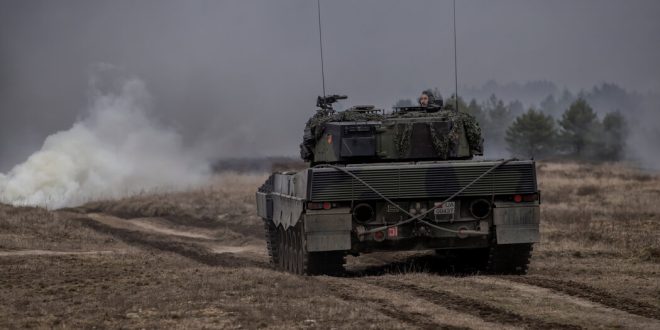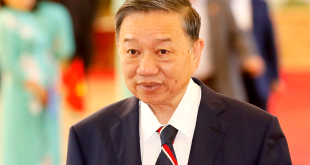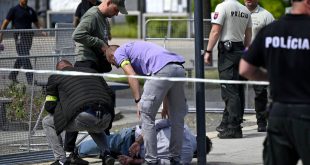SWIETOSZOW, Poland — One by one, Leopard tanks crewed by Ukrainian troops and their Polish instructors zipped up a muddy field, bouncing over deep ruts and cresting a low dirt berm. They stopped, fired smoke grenades, then raced back in reverse to their starting points.
The demonstration on Monday, for President Andrzej Duda of Poland and his defense minister, was the first since Ukrainian troops began training on the Leopard 2A4 tanks after being promised them by Western allies nearly three weeks ago. With a massive Russian operation already building in eastern Ukraine, officials said they had compressed the tutelage for operating and maintaining the machines — which usually takes up to a year — into a couple of months.
Ukraine’s leaders and their NATO backers hope the German-made tanks will be a crucial part of a campaign to push Russian forces out of the cities and towns where fighting has been centered in recent weeks. The Leopards, which move as swiftly backward as they do forward, are considered particularly useful for urban combat.
Ukrainian Maj. Vadym Khodak, 57, said he and his fellow soldiers had been pulled off the front lines in Donetsk and Luhansk, the provinces that make up the heavily contested Donbas region in eastern Ukraine, and given three days to report to this drab Polish base near the German border.
“These tanks will be a great support for our army,” said Major Khodak, who volunteered for military service after Russia invaded last year. “Using them in combat conditions will have a great effect.”
He said he and the other Ukrainian troops already had experience with tanks, but not equipment as advanced as the Leopards. Mostly, they have used Kyiv’s arsenal of Soviet-era machines, steadily dwindling as vehicles are destroyed in combat.
“At the moment, we are very short of armored vehicles and I hope that when we get to the front line with this equipment, it will save a lot of lives of our soldiers and bring us closer to victory,” Major Khodak said.
Monday’s demonstration in Poland came on the same day that another group of Ukrainian troops began their training on Leopard 2 tanks in Germany. Still another group is being trained in Britain on that country’s Challenger 2 tanks.
But Monday’s brief public event was the first to showcase the process in what has increasingly become a race within NATO to demonstrate support for Ukraine — and, in doing so, pressure more cautious states into stepping up — and head off an expected Russian offensive.
“These modern weapons, we hope, will help them defeat the enemy far more efficiently than has been the case so far,” Mr. Duda said.
Poland had long leaned on its allies to agree to sending tanks to Ukraine, ultimately wearing down resistance from the United States and Germany, where leaders worried about the possibility of further escalating the conflict. Poland and several other countries lobbied Berlin to give them permission to re-export their own Leopards, and to supply them directly. After Britain last month became the first to commit to sending Western tanks, Germany agreed.
That decision came in late January, only after the Biden administration agreed to send 31 American-made tanks. Germany pledged to send 14 Leopard 2s from its stockpile, and later agreed to also send as many as 88 of its older Leopard 1 tanks.
Mr. Duda said the donations were necessary “so that Ukraine can counter the Russian onslaught with modern tanks in the standard adopted by the North Atlantic Alliance — much more modern than what it had so far.”
Britain, Poland and Germany are racing to deliver their tanks this spring or early summer; officials in Berlin said on Monday they hoped to complete training of the Ukrainian troops by the end of March.
Combined with a small number of additional tanks from Canada and Norway, Mr. Duda said he hoped there would be enough for Ukraine to field a full armored brigade — usually about 65 tanks — in the near future. (The Pentagon has cautioned it will take months before its advanced M1A2 Abrams tanks will reach the battlefield.)
Many Western military planners believe the tanks — along with other fighting vehicles now being deployed, like American Bradleys and Strykers — could help turn the tide of the war.
David A. Ochmanek, a former U.S. deputy assistant secretary of defense, said the tanks would be a key addition to the ongoing artillery battle, which has largely devolved into a war of attrition.
High-precision artillery fire is a hammer that is “only effective when it has an anvil,” Mr. Ochmanek, now a senior analyst at the RAND Corporation, told a recent briefing in Washington. “And heavy ground forces provide the anvil.”
But time is of the essence. Fighting has intensified around the eastern city of Bakhmut, where Russian forces are slowly advancing and the Ukrainian military on Monday barred aid workers and groups from entering, saying it was too dangerous.
The Ukrainians training in Poland are putting in 12-hour days, six days a week — an accelerated pace from what instructors described as a normal schedule of eight hours a day, five days a week. Much of it is being done on simulators, which Mr. Duda said were helping the crews learn how to drive, navigate, and fire.
While waiting for Monday’s eight-minute demonstration to begin, some of the Ukrainians waved at the assembled TV cameras but others busied themselves by turning their turrets back and forth.
Major Khodak said the soldiers believed the Leopard tanks will have a “great effect” in combat conditions. He added: “There is a saying: Better late than never.”
Tolek Magdziarz in Warsaw, Anastasia Kuznietsova in Mantua, Italy, and Christopher F. Schuetze in Berlin contributed reporting.
 Top Naija News – Nigeria News, Nigerian News & Top Stories Top Naija News – Nigerian Newspapers, Nigerian News. topnaijanews is a daily Nigerian newspaper covering Latest News, Breaking News, Entertainment, Sports, Lifestyle and Politics.
Top Naija News – Nigeria News, Nigerian News & Top Stories Top Naija News – Nigerian Newspapers, Nigerian News. topnaijanews is a daily Nigerian newspaper covering Latest News, Breaking News, Entertainment, Sports, Lifestyle and Politics.




